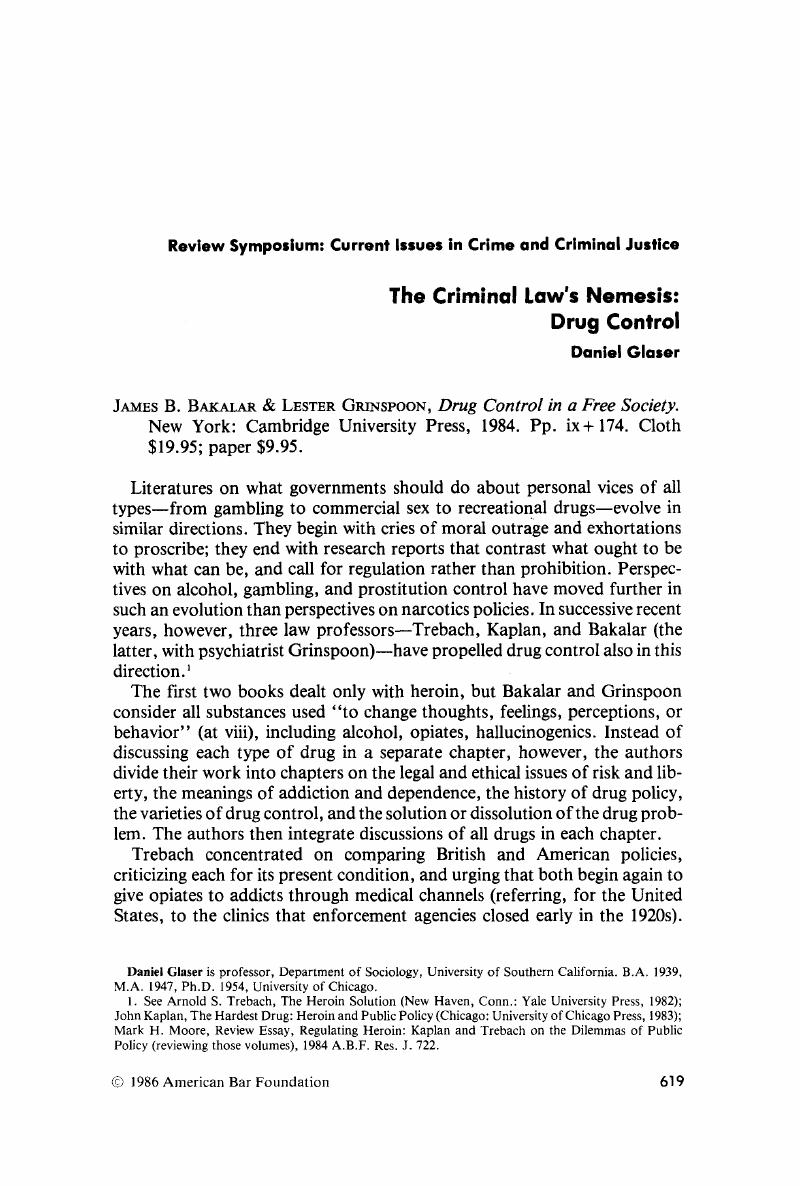Article contents
The Criminal Law's Nemesis: Drug Control
Published online by Cambridge University Press: 20 November 2018
Abstract

- Type
- Review Symposium: Current Issues in Crime and Criminal Justice
- Information
- Copyright
- Copyright © American Bar Foundation, 1985
References
1 See Trebach, Arnold S., The Heroin Solution (New Haven, Conn.: Yale University Press, 1982); John Kaplan, The Hardest Drug: Heroin and Public Policy (Chicago: University of Chicago Press, 1983); Mark H. Moore, Review Essay, Regulating Heroin: Kaplan and Trebach on the Dilemmas of Public Policy (reviewing those volumes), 1984 A.B.F. Res. J. 722.Google Scholar
2 Ball, John C., Two Patterns of Narcotic Drug Addiction in the United States, 56 J. Crim. L., Criminology, & Police Sci. 203 (1965).CrossRefGoogle Scholar
3 Blumstein, Alfred, Cohen, Jacqueline, & Miller, Harold D., Crime, Punishment, and Demographics, 2 Am. Demographics 32 (1980); Felson, Marcus & Gottfredson, Michael, Social Indicators of Adolescent Activities Near Peers and Parents, 46 J. Marriage & Fam. 709 (1984).Google Scholar
4 Jan M. Chaiken & Marcia M. Chaiken, Crime Rates and the Active Criminal, in James Q. Wilson, ed., Crime and Public Policy (New Brunswick, N.J.: Transaction Books, 1983).Google Scholar
5 National Narcotics Intelligence Consumers Committee, Narcotics Intelligence Estimate, 1983, at 35 (Washington, D.C.: Drug Enforcement Administration, 1984).Google Scholar
6 Hulsman, Louk H. C., Holland: Liberalisierung um welchen Preis? (Liberalization at What Price?), 8 Drogalkohol 66 (1984); id., Heroine, Criminaliteit en Sociale Reacties (Heroin, Criminality and Social Reactions), 26 Tijdschrift voor Criminologie 73 (1984); Sebastian Scheerer, The New Dutch and German Drug Laws: Social and Political Conditions for Criminalization and Decriminalization, 12 Law & Soc'y Rev. 585 (1978).Google Scholar
7 Bruno, Francesco, ed., Combatting Drug Abuse and Related Crime, pub. no. 21, at 177 (Rome: United Nations Social Defence Research Institute, 1984).Google Scholar
8 National Institute on Drug Abuse, Main Findings for Drug Abuse Treatment Units, Sept. 1982, Statistical Series F, no. 10, table 2.01 (Rockville, Md.: National Institute on Drug Abuse, 1983).Google Scholar
9 Durkheim, Emile, The Division of Labor in Society, trans. W. D. Halls (New York: Free Press, 1984).Google Scholar
10 Parsons, Talcott, The Evolution of Societies (Englewood Cliffs, N.J.: Prentice-Hall, 1977).Google Scholar
11 Heer, David M., Felson, Marcus, & Hodge, Robert W., The Cluttered Nest: Evidence That Young Adults are More Likely to Live at Home Now Than in the Recent Past, 69 Soc. & Soc. Research 436 (1985).Google Scholar
12 Johnston, Lloyd D., Patrick M. O'Malley, & Jerald G. Bachman, Highlights from Drugs and American High School Students, 1975–1983 (Rockville, Md.: National Institute on Drug Abuse, 1984); id., University of Michigan Survey Research Center, news release (Jan. 4, 1985); and id., tables from the 1984 NIDA survey (unpublished and supplied to this reviewer).Google Scholar
13 America's Fitness Binge, U.S. News & World Rep., May 3, 1982, at 58.Google Scholar
14 J. Michael Polich et al., Strategies for Controlling Adolescent Drug Use (Santa Monica, Cal.: Rand, 1984); Gilbert J. Botvin, Prevention of Adolescent Substance Abuse Through the Development of Personal and Social Competence, in Thomas J. Glynn et al., eds., Preventing Adolescent Drug Abuse: Intervention Strategies, Research Monograph No. 47 (Rockville, Md.: National Institute on Drug Abuse, 1983).Google Scholar
- 1
- Cited by


